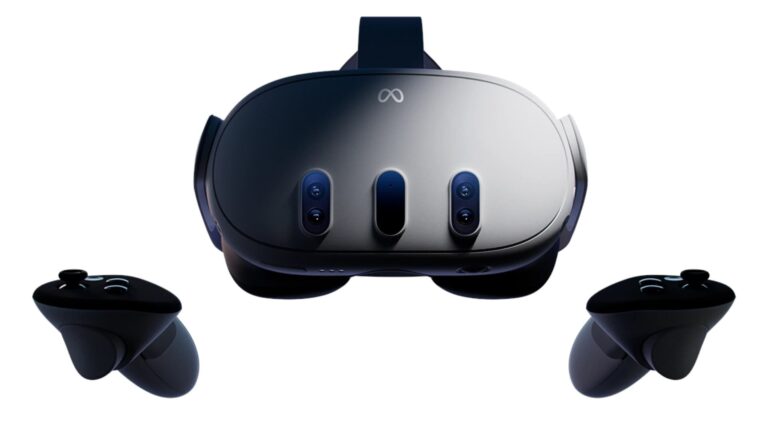
As you may have heard, Meta recently announced Q4 earnings. The company had a breakout quarter that beat analyst estimates, including 25 percent year-over-year revenue growth and an 8 percent year-over-year decline in operating expenses (mostly due to all those layoffs).
Sitting under those positive results – and Wall Street’s reaction – Meta Reality Labs’ (MRL) revenue hit a record high of $1.1 billion. This is up 524 percent from a dismal Q3, and 25 percent year-over-year, the latter being more of an apples-to-apples comparison given seasonal cycles.
Revenue growth was mostly due to the standard Q4 holiday lift, plus a Quest 2 price drop and Quest 3 market entrance. The bad news was record MRL operating costs of 5.72 billion. But the headline is that VR sales have rebounded substantially from Q3’s notable rut (as we predicted).
There’s a lot to be said about that timing and market positioning. But our main question today is how Q4 revenue translates to headset unit sales. This is an exercise we’ve done every quarter for several years, which helps inform broader VR momentum and market sizing.
Data Dive
Diving in, Reality Labs made $1.1 billion in Q4, as noted. As done in the past, we can use this figure to reverse-engineer unit sales. This exercise gets harder and harder every year due to more revenue sources. It’s not just Quest 2 anymore… but several other headsets in the mix.
To that end, we’ve estimated Meta Reality Labs’ revenue share breakdowns based on several signals we’re tracking. You can see those share estimates below. In this hardware-centric exercise, we’ll focus on the last four bullets, which account for 80 percent of MRL revenue.
- VR software (game & app sales): 18 percent*
- First-party accessories (head straps, etc): 2 percent
- Quest 2: 33 percent
- Quest 3: 38 percent
- Quest Pro: 2 percent
- Ray-Ban Meta Smart Glasses: 7 percent
Quest 2
Based on the above revenue shares, Quest 2’s estimated Q4 revenue is $363 million. Considering a Q4 average unit price of $290**, Meta sold approximately 1,251,724 units during the quarter.
Quest 3
Based on the above revenue shares, Quest 3’s estimated Q4 revenue is $418 million. Considering a Q4 average unit price of $549***, Meta sold approximately 761,384 units during the quarter.
Quest Pro
Based on the above revenue shares, Quest Pro’s estimated Q4 revenue is $22 million. Considering a Q4 unit price of $999, Meta sold approximately 22,022 units during the quarter.
Ray-Ban Meta Smart Glasses
Based on the above revenue shares, RBMS estimated Q4 revenue is $77 million. Considering a Q4 unit price of $329, Meta sold approximately 234,043 units during the quarter.
Grand Total
Adding up all headsets, we get an estimated 2,269,173 units sold in Q4 – or 2,035,130 if considering just VR headsets.
*This figure represents the Oculus Store’s gross revenue, before developer payouts, which are usually 70 percent after taxes. Meta realizes 100 percent of revenue in some cases, such as first-party titles and releases from VR game studios it has acquired (e.g., Beat Games).
**During the height of Q4 spending (cyber week), a $50 price drop positioned Quest 2’s base model (128GB) at $249 while the 256GB model was $299. This averages out at $274, however, the average for the entire quarter is slightly higher at $290, given non-promotional periods that are weighted lower.
***During Q4, Quest 3’s 128GB base model was $499.99 while the 512GB model was $649.99. This averages out to $549, given weighted sales at the lower end.
Rally Cry
So there you have it. Of course, much of this exercise is based on the above-estimated revenue shares across Meta Reality Labs’ commercial products. Those share estimates are educated but up for debate: anyone can adjust them and calculate accordingly using the above model.
While we’re at it, there are a few other qualifications worth noting. For one, notice how Quest 3’s revenue share is higher than Quest 2, but it sold fewer units. This is simply due to its price tag – almost twice that of Quest 2. Quest 2’s Q4 price drop also drove ample holiday sales.
In fact, you may remember reports in December that holiday sales data extracted from distributors like Amazon showed Quest 2 outselling Quest 3 by a large margin. Those sales figures were in units, not dollars, which aligns in principle with our calculations in the model above.
Speaking of alignment, Quest 3’s unit estimate squares with other signals, such as the First Encounters leaderboard that we wrote about last week. If our estimate is correct, it means 65 percent of Quest 3 users played the bundled game in Q4 – within the range we speculated.
One lesson in all of the above is that extrapolations and a dash of creativity are required to triangulate Meta’s unit sales. Why is that important? As the market share leader, Meta’s VR sales are a key signal for current market demand and aggregate health of the broader XR sector.
In that sense, Meta has validated meaningful demand. It still has ways to go, but these numbers offer encouragement as a sort of rally cry. Meanwhile, all the above could accelerate from Apple’s halo effect. In fact, Vision Pro could be the best thing that ever happened to Quest 3.






